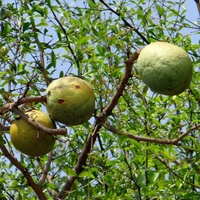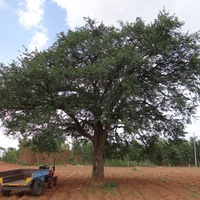Common name: Bael
Other common names: Golden apple, Holy fruit, Indian quince, Stone apple, Wood apple
Description
A citrus relative, this fruit-bearing tree is native to the dry forests on the hills and plains of central and southern India. It is considered a sacred tree in Hindu culture and is similarly revered in Buddhist culture. Because of its sacred status, the wood apple is often found in temple gardens in both India and Thailand. In Hindu culture, the leaves of the tree are used in religious ceremonies as an offering to Lord Shiva, who is believed to live beneath the tree. In Thailand, the sliced and dry fruit are boiled in water and is a popular tea with temple monks. Where sacred, the trees are not allowed to be uprooted.
This fruit bearing citrus relative
The wood apple is introduced and now naturalised in many countries, including Malaysia, the Philippines, Egypt, Surinam, Trinidad and Florida, in the USA where small collections exist. It has nutritive, curative and pesticidal properties and is highly prized for its medicinal virtues, more so than for its edible qualities.
The tree is a slow growing, medium sized tree 8 to 14 meters tall with a short trunk and sprawling habit, sometimes drooping branches. The bark is smooth, thick, soft, flaking with a greyish-brown colour. The older branches are covered with straight, sharp spines, as are the young suckers which can develop around the tree.
Wounds to the trunk exude a clear gum, resembling gum Arabic, which hangs down in long strands as it drains and becomes solid. If eaten, it is sweet at first, but them becomes irritating to the throat.
Flowers are greenish white in colour. Fruit vary in size from around 5 to 20 cm in diameter, the smaller fruit comparable in size to an orange and the larger to a grapefruit.
The rind can be thin, hard and woody, or it may be softer. It is green when unripe turning to yellow when ripened. There are 8 to 16 segments inside the fruit, with seeds in a clear, sticky, edible yellow pulp. The pulp is sticky with a soft, marmalade like consistency with a sweet flavour when the fruit is ripe. Seeds are enclosed in a sac of adhesive mucilage, which solidifies on drying.
The fruit pulp is eaten in many parts of the world, but more for its medicinal qualities than for taste.
All parts of the plant, including the stem, bark, leaves, fruits, and roots at any stage of development, have some use. The unripe as well as ripe fruits can be used for making sweet preserve, jam, candies, toffees and soft drinks. Slices of green fruit are sundried and stored for future use.
The fruit pulp can be used for washing clothes. The gum from unripe fruit as glue as well as a protective coating on paintings. Wood apple trees propagated from seedlings show a wide variation in spininess, fruit size and fruit quality. Superior cultivars have been developed mainly in India and two of the most esteemed are, 'Kaghzi', a large fruit cultivar with thin rind and few seeds, and 'Matizapuri', very thin rind, fine textured pulp, free of gum, excellent flavor, and containing few seeds. [SC]
.5888.thumb.jpg)



